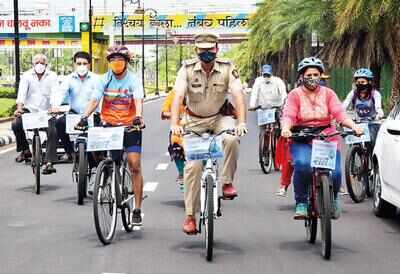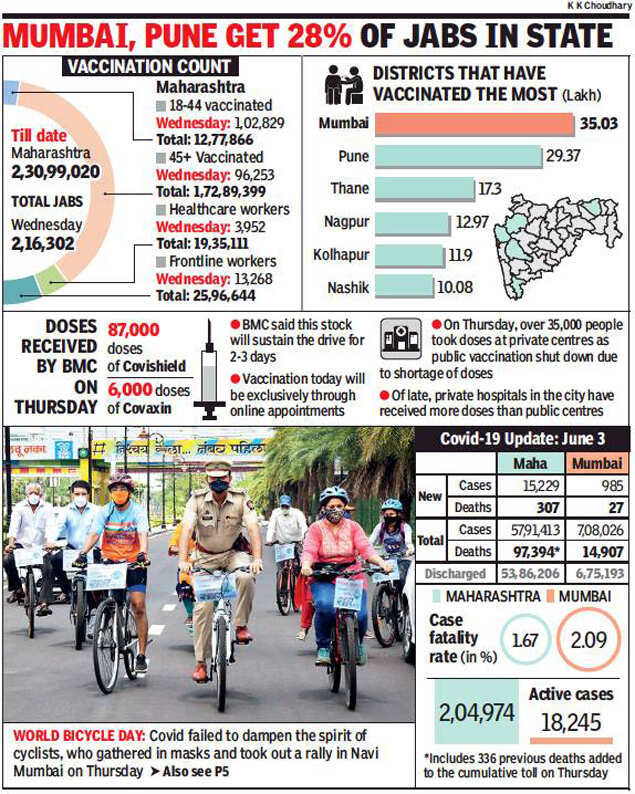Top Searches
- News
- City News
- mumbai News
- Mumbai: Genome mapping, analytics to help ward off third wave
Mumbai: Genome mapping, analytics to help ward off third wave

Covid failed to dampen the spirit of cyclists, who gathered in masks and took out a rally inn Navi Mumbai On Thursday
MUMBAI: The BMC will use science — from genome mapping to machine learning analytics — to try and stymie the third Covid-19 wave, if and when it arrives. “We will have our genomic laboratory ready later this month and we are in the process of tying up with management institutes to analyse past Covid trends in the city to arrive at answers,” said BMC additional municipal commissioner Suresh Kakani.

Four wards — B (Bhendi Bazar), C (Girgaum), L (Kurla) and M (Mankhurd, Govandi East) — have been shortlisted for the analysis mainly because they had a Covid incidence of less than 3,000 per lakh population throughout the pandemic. “All other wards had a higher incidence. Mapping out reasons that clicked in these four wards will help use plan better,” said Kakani.
Also, the BMC’s first whole genome sequencing laboratory will come up at Kasturba Hospital near Saat Raasta. The idea is to find variants of concern in Covid-positive samples at the earliest and implement public health measures, he added.
As part of the ward analysis, the L ward office has already received a set of questionnaires from the head office and has begun collecting data. “The ward has several large slum pockets such as Qureshi Nagar, Zari mari, Sangarsh Nagar that have a high population density,’’ said ward medical health officer Dr Jitendra Jadhav.
Teams have started calling up Covid-recovered patients as well as those who didn’t get infected to collect personal data on eating and travelling habits, sanitation facilities available to them and their socio-economic condition.
C ward corporator Atul Shah said the study would underline the fact that lower middle-class people who reside in areas such as Kumbharwada and Bhendi Bazar followed the “mask discipline seriously”. Public health exercises such as keeping tabs on patients via the telephone and ensuring quarantine rules paid off in the ward, said health officer Dr Pramod Patil.
MLA Amin Patel said herd immunity may have kicked in in some of these wards under study. “In wards B and C, the majority lives in small homes with common toilets. Social distancing is a challenge in these wards, resulting in herd immunity in these 14 months,” he said. C ward has large markets such as Mangaldas market, Zaveri Bazar, Lohar Chawl, metal and stainless steel markets that remained shut throughout the lockdown. “This automatically reduced the floating population in the area,” said Patel.

Four wards — B (Bhendi Bazar), C (Girgaum), L (Kurla) and M (Mankhurd, Govandi East) — have been shortlisted for the analysis mainly because they had a Covid incidence of less than 3,000 per lakh population throughout the pandemic. “All other wards had a higher incidence. Mapping out reasons that clicked in these four wards will help use plan better,” said Kakani.
Also, the BMC’s first whole genome sequencing laboratory will come up at Kasturba Hospital near Saat Raasta. The idea is to find variants of concern in Covid-positive samples at the earliest and implement public health measures, he added.
As part of the ward analysis, the L ward office has already received a set of questionnaires from the head office and has begun collecting data. “The ward has several large slum pockets such as Qureshi Nagar, Zari mari, Sangarsh Nagar that have a high population density,’’ said ward medical health officer Dr Jitendra Jadhav.
Teams have started calling up Covid-recovered patients as well as those who didn’t get infected to collect personal data on eating and travelling habits, sanitation facilities available to them and their socio-economic condition.
C ward corporator Atul Shah said the study would underline the fact that lower middle-class people who reside in areas such as Kumbharwada and Bhendi Bazar followed the “mask discipline seriously”. Public health exercises such as keeping tabs on patients via the telephone and ensuring quarantine rules paid off in the ward, said health officer Dr Pramod Patil.
MLA Amin Patel said herd immunity may have kicked in in some of these wards under study. “In wards B and C, the majority lives in small homes with common toilets. Social distancing is a challenge in these wards, resulting in herd immunity in these 14 months,” he said. C ward has large markets such as Mangaldas market, Zaveri Bazar, Lohar Chawl, metal and stainless steel markets that remained shut throughout the lockdown. “This automatically reduced the floating population in the area,” said Patel.
FacebookTwitterLinkedinEMail
Start a Conversation
end of article
